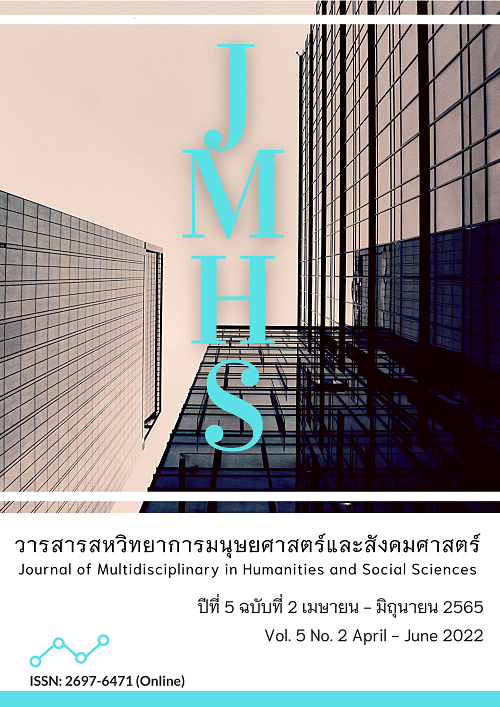A Study of The Enlightenment of Vakkali Bhikkhu in Vakkali Sutta
Main Article Content
Abstract
The objectives of this article were 1) to study the enlightenment approach found in early Buddhism and 2) to study the enlightenment of Vakkali Bhikkhu that appeared in the Vakkali Sutta. Research data was taken from primary texts of Early Buddhism and other related documents, summed up, analyzed, and compiled in a descriptive style. The result revealed that Vakkali Bhikkhu attained enlightenment through the Blessed One’s visit, who was greatly enraged. Having known Vakkali’s serious sickness due to his longing to come and see him; the Buddha said that seeing his flesh body was useless; those who see Dhamma will see him, those who saw him will truly see Dhamma; and taught him to observe pains by defining the state of pains that arise as it really is without any alteration, such as the feeling of bodily suffering, called Kāyikadukkha, etc.; and the five aggregates, namely form, feeling, perception, thought, and consciousness, as impermanent, suffering, and non-self, then returning to his dwelling place. Later, Vakkali committed suicide by attaining Arahatship along with the quenching of the mind.
Article Details

This work is licensed under a Creative Commons Attribution-NonCommercial-NoDerivatives 4.0 International License.
Views and opinions appearing in the Journal it is the responsibility of the author of the article, and does not constitute the view and responsibility of the editorial team.
References
ชัยชาญ ศรีหานู. (2564). วิเคราะห์คำสอนวิปัสสนาในเตภูมิกถาที่มีผลต่อคตินิยมเชิงพุทธในสังคมไทย. วารสาร มจร บาฬีศึกษาพุทธโฆสปริทรรศน์, 7(1), 12-26.
พระธรรมกิตติวงศ์ (ทองดี สุรเตโช). (2554). พจนานุกรม เพื่อการศึกษาพุทธศาสน์ คำวัด. กรุงเทพฯ: ธรรมสภาและสถาบันบันลือธรรม.
พระพรหมคุณาภรณ์ (ป.อ.ปยุตฺโต). (2557). พจนานุกรมพุทธศาสตร์ ฉบับประมวลธรรม. (พิมพ์ครั้งที่ 27). กรุงเทพฯ: โรงพิมพ์มหาจุฬาลงกรณราชวิทยาลัย.
พระพรหมคุณาภรณ์ (ป.อ.ปยุตฺโต). (2555). พุทธธรรม ฉบับปรับขยาย. (พิมพ์ครั้งที่ 35). กรุงเทพฯ: ผลิธัมม์.
พุทธโฆสเถระ. (2548). คัมภีร์วิสุทธิมรรค. (สมเด็จพระพุฒาจารย์ (อาจ อาสภมหาเถระ), แปล). (พิมพ์ครั้งที่ 6). กรุงเทพฯ: ธนาเพรส.
พระมหาพงศ์ศิริ ปญฺญาวชิโร. (2564). วิเคราะห์ทานบารมีในคัมภีร์อรรถกถาชาดก. วารสารสหวิทยาการมนุษยศาสตร์และสังคมศาสตร์, 4(1), 63-73.
พระสมหมาย สมสิทฺโธ. (2564). ศึกษาการปฏิบัติวิปัสสนาภาวนาในอาสีวิโสปมสูตร. วารสาร มจร บาฬีศึกษาพุทธโฆสปริทรรศน์, 7(2), 129-139.
พระโสภณมหาเถระ (มหาสีสยาดอ). (2549). มหาสติปัฏฐานสูตร. (พระคันธสาราภิวงศ์, แปล). กรุงเทพฯ: ไทยรายการพิมพ์.
มหาจุฬาลงกรณราชวิทยาลัย. (2539). พระไตรปิฎกภาษาไทย ฉบับมหาจุฬาลงกรณราชวิทยาลัย. กรุงเทพฯ: โรงพิมพ์มหาจุฬาลงกรณราชวิทยาลัย.
มหาจุฬาลงกรณราชวิทยาลัย. (2552). อรรถกถาภาษาไทย ฉบับมหาจุฬาลงกรณราชวิทยาลัย. กรุงเทพฯ: โรงพิมพ์มหาจุฬาลงกรณราชวิทยาลัย.
มาโนช น้อยวัฒน์. (2551). อนุปุพพิกถาและอริยสัจ. กรุงเทพฯ: ชมรมอนุรักษ์ธรรม.
ราชบัณฑิตยสถาน. (2546). พจนานุกรมฉบับราชบัณฑิตยสถาน พ.ศ. 2542. กรุงเทพฯ: นานมีบุ๊คส์พับลิเคชั่นส์.
อุไรพร ประชาบุตร และ วิไลศักดิ์ กิ่งคำ. (2564). ศึกษาความสัมพันธ์ระหว่างอานาปานสติกับไตรลักษณ์ในคัมภีร์พระพุทธศาสนาเถรวาท. วารสาร มจร บาฬีศึกษาพุทธโฆสปริทรรศน์, 7(2), 1-12.
Tan, C. C., & Damnoen, P. S. (2020). Buddhist Noble Eightfold Path Approach in the Study of Consumer and Organizational Behaviors. Journal of MCU Peace Studies, 8(1), 1–20.


